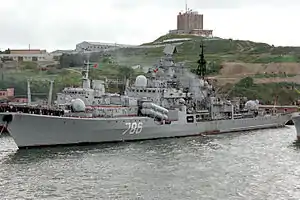Russian destroyer Bystryy
Bystryy is a Sovremenny-class destroyer of the Russian Navy.[1]
 Bystryy on 9 September 1992 | |
| History | |
|---|---|
| Name: |
|
| Namesake: | Bystryy |
| Builder: | Severnaya Verf, Saint Petersburg |
| Laid down: | 29 October 1985 |
| Launched: | 28 November 1987 |
| Commissioned: | 30 September 1989 |
| Homeport: | Vladivostok |
| Identification: | Pennant number: 676, 715, 786 |
| Status: | Active |
| General characteristics | |
| Class and type: | Sovremenny-class destroyer |
| Displacement: | 6,600 tons standard, 8,480 tons full load |
| Length: | 156 m (511 ft 10 in) |
| Beam: | 17.3 m (56 ft 9 in) |
| Draught: | 6.5 m (21 ft 4 in) |
| Propulsion: | 2 shaft steam turbines, 4 boilers, 75,000 kW (100,000 hp), 2 fixed propellers, 2 turbo generators,and 2 diesel generators |
| Speed: | 32.7 knots (60.6 km/h; 37.6 mph) |
| Range: |
|
| Complement: | 350 |
| Sensors and processing systems: |
|
| Electronic warfare & decoys: | 2 PK-2 decoy dispensers (200 rockets) |
| Armament: |
|
| Aircraft carried: | 1× Ka-27 series helicopter |
| Aviation facilities: | Helipad |
Development and design
Project began in the late 1960s when it was becoming obvious in the Soviet Navy that naval guns still had an important role particularly in support of amphibious landings, but existing gun cruisers and destroyers were showing their age. A new design was started, employing a new 130 mm automatic gun turret.
The ships are 156 metres (511 ft 10 in) in length, with a beam of 17.3 metres (56 ft 9 in) and a draught of 6.5 metres (21 ft 4 in).
Construction and career
Bystryy was laid down on 29 October 1985 and launched on 28 November 1987 by Severnaya Verf in Saint Petersburg.[2] She was commissioned on 30 September 1989.
From June 3 to June 28, 2013, a detachment of ships Bystryy, Oslyabya and Kalar left Vladivostok and went to the military-historical naval Campaign of Memory dedicated to the Victory in the Great Patriotic War, 282nd anniversary of the Pacific Fleet and the 200th anniversary of the birth of Admiral G. I. Nevelskoy. The route of the campaign was Vladivostok - Nevelsk - Yuzhno-Kurilsk - Severo-Kurilsk - Vilyuchinsk - Okhotsk - Korsakov - Yuzhno-Sakhalinsk - Vladivostok. The ships covered 4200 miles in 25 days.[3][4]
As of the beginning of 2015, since its construction, the ship has covered 43,792 nautical miles, 13 people from the ship's crews have been awarded government awards.
On January 27, 2016, the destroyer arrived at its homeport, Vladivostok. According to the results of 2016, the destroyer crew became the best among the missile and artillery ships of rank 1-2 of the Russian Navy in the competition for the prize of the Commander-in-Chief of the Russian Navy.[5]
References
- "Destroyers - Project 956". russianships.info. Retrieved 2020-12-17.
- "Sovremenny". web.archive.org. 2005-11-04. Retrieved 2020-12-17.
- "«Поход памяти» кораблей Тихоокеанского флота возвращается во Владивосток". www.korabli.eu (in Russian). 2013-06-27. Retrieved 2020-12-17.
- "Корабли «Похода памяти» Тихоокеанского флота покинули Камчатку". www.korabli.eu (in Russian). 2013-06-17. Retrieved 2020-12-17.
- function.mil.ru https://function.mil.ru/news_page/country/more.htm?id=12104509@egNews. Retrieved 2020-12-17. Missing or empty
|title=(help)